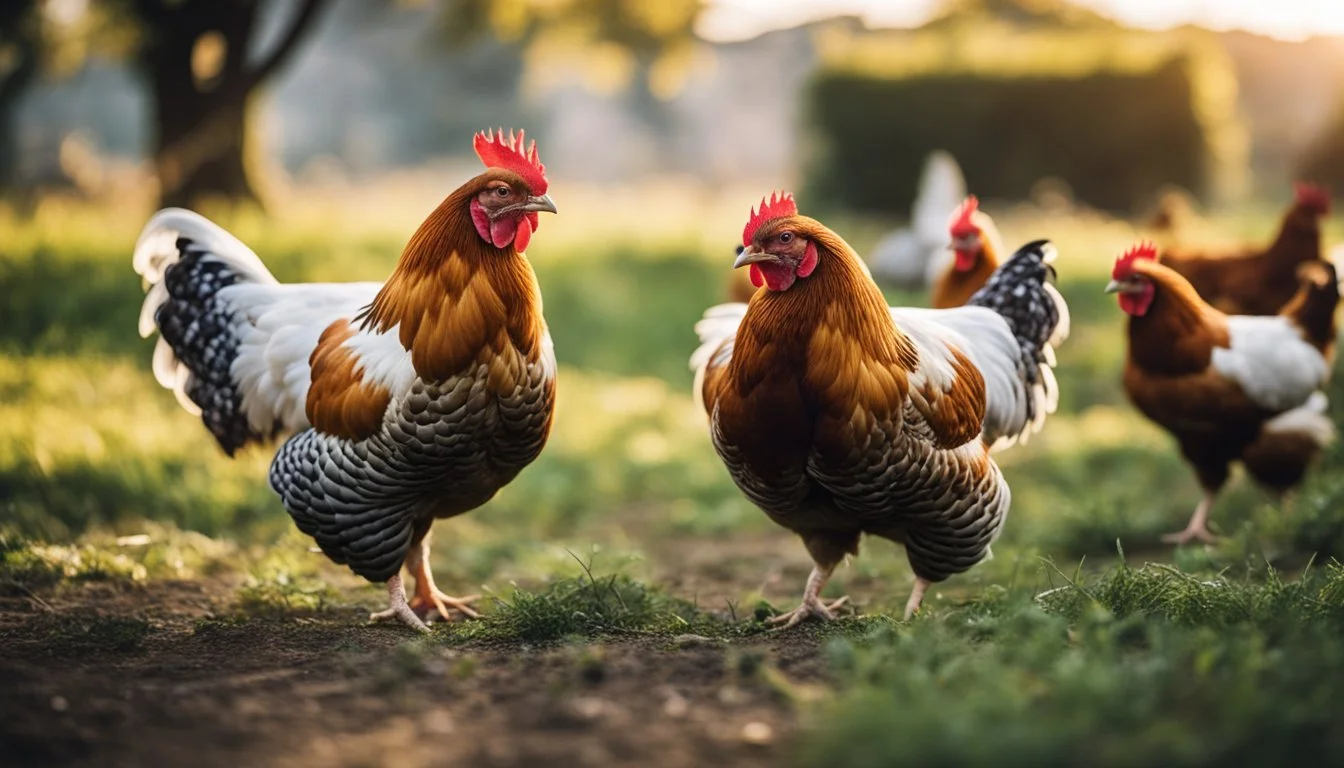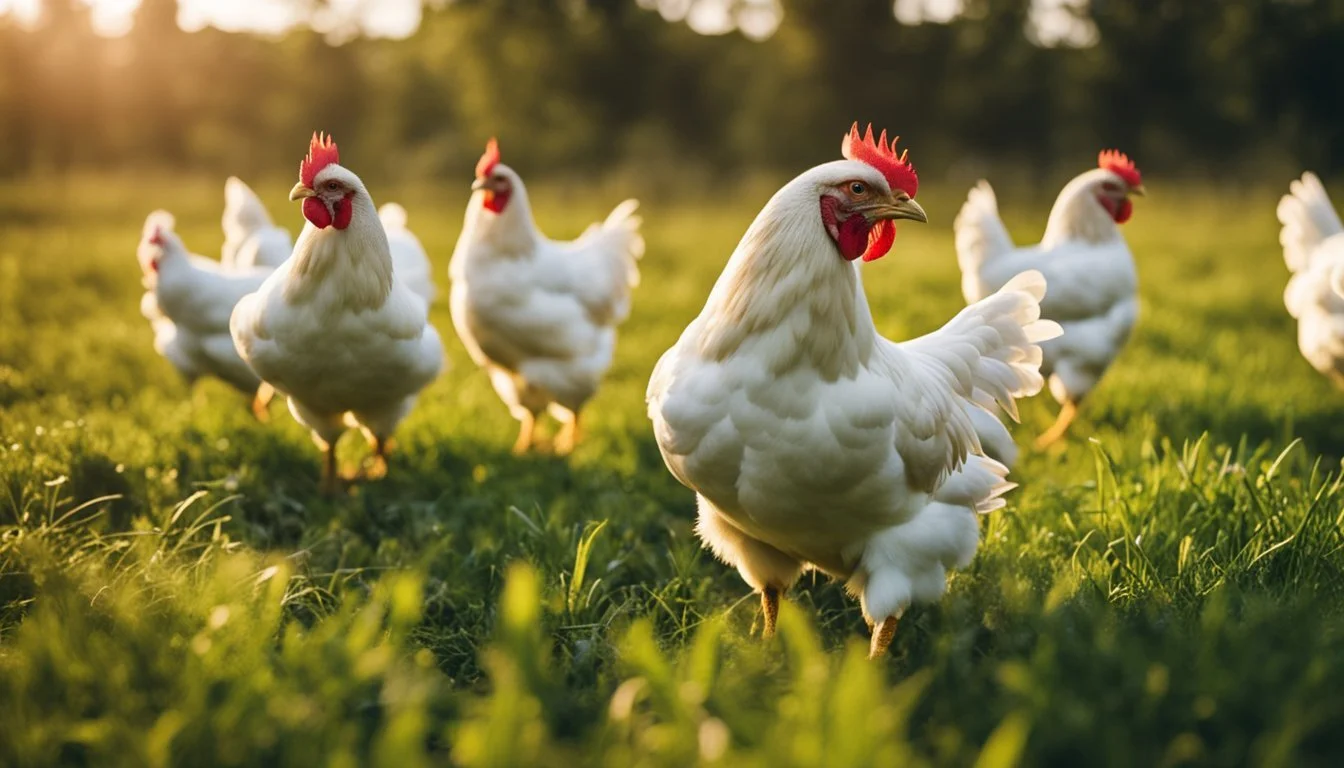8 Common Chicken Myths Debunked
Uncovering the Truth About Poultry
Raising backyard chickens has surged in popularity, as more people seek to enjoy fresh eggs and a closer connection to their food sources. Despite this trend, numerous myths persist, often deterring potential poultry enthusiasts from embarking on their chicken-keeping journey.
Clearing up these misconceptions can help prospective chicken owners make informed decisions and enjoy a successful experience. Understanding the realities of chicken care not only dispels unwarranted fears but also highlights the true benefits and manageable challenges of keeping these fascinating birds.
1) You need a rooster for hens to lay eggs.
One prevalent myth in poultry raising is the notion that hens need a rooster to lay eggs. This is not true. Hens will lay eggs naturally as part of their reproductive cycle, regardless of whether a rooster is present.
Roosters are not required for egg production; they are only necessary if the goal is to have fertilized eggs for breeding purposes. Fertilized eggs can develop into chicks, while unfertilized eggs are what we commonly consume.
The presence of a rooster does not increase the number of eggs a hen lays. Factors like diet, light exposure, and environment play a more crucial role in egg production. Ensuring hens have a stress-free environment and proper nutrition can help maximize their egg-laying potential.
There are other benefits to having roosters, such as providing protection to the flock and maintaining social order. However, these benefits do not extend to influencing the hen's ability to lay eggs.
2) Brown eggs are healthier than white eggs.
A common belief is that brown eggs are healthier than white eggs. This idea likely stems from other food comparisons, such as brown bread being healthier than white bread.
In reality, the nutritional content of eggs is not determined by their shell color. Both brown and white eggs offer the same benefits if the chickens are fed the same diet.
The color difference in egg shells is due to the breed of the chicken. Brown eggs come from chickens with red feathers and earlobes, while white eggs come from chickens with white feathers and earlobes.
Nutrient levels, such as protein and cholesterol, are the same in brown and white eggs. Therefore, when choosing between the two, consumers can make their decision based on personal preferences or cost.
Brown eggs might sometimes cost more, but this price difference is largely due to the larger breed of chickens that lay them, which require more feed.
3) Chickens can't fly.
A common misconception is that chickens cannot fly at all. While they are not capable of sustained flight like eagles or hawks, they do possess the ability to fly short distances.
Chickens can typically fly up to 10 feet in the air. This altitude helps them roost in trees or escape predators. Their flight usually spans around 50 feet horizontally, making it a brief but effective means of movement.
The anatomy of chickens contributes to their limited flight ability. Their wings are shorter and sturdier compared to birds designed for long flights. Despite these limitations, chickens can still perform short bursts of flight when necessary.
Chickens' flight is often used strategically rather than for long journeys. They might fly up to a perch or over a fence to reach safety or food. This ability highlights their adaptability and survival skills.
Understanding the flight capabilities of chickens can help ensure they are kept in an environment that maximizes their safety. High fences and enclosed spaces can prevent them from flying into unsafe areas.
Thus, while chickens are not high flyers, dismissing their ability to fly altogether is inaccurate. Their short flights play a meaningful role in their daily lives.
4) Store-bought eggs are always safer than farm-fresh eggs.
The belief that store-bought eggs are always safer than farm-fresh eggs is widespread.
Store-bought eggs undergo rigorous inspection and pasteurization processes, which are designed to reduce the risk of bacterial contamination. This can contribute to a perception of higher safety.
Farm-fresh eggs, especially those from free-range chickens, often have better nutritional profiles. They contain more vitamins and omega-3 fatty acids.
It’s important to note that both store-bought and farm-fresh eggs can carry risks if not handled properly. Proper storage and handling are crucial no matter where the eggs come from.
The misconception arises mainly from visibility and regulation. Store-bought eggs are produced under controlled conditions, making their production appear safer.
However, farm-fresh eggs, when sourced from reputable farms that follow good practices, can be just as safe. Ensuring that eggs from both sources are kept at the correct temperature and are not past their expiration date is essential for safety.
In essence, safety depends more on handling and storage practices rather than the egg's origin. Both types can be safe if proper guidelines are followed.
5) Organic chickens are always free-range.
The misconception that organic chickens are always free-range is widespread. Organic certification primarily ensures that the chickens are fed organic feed and are raised without synthetic pesticides, antibiotics, or other chemicals. However, it does not necessarily mean that the chickens have extensive access to the outdoors.
Organic chickens can be raised in various ways. Some may have more space and access to outdoor areas, while others might only have limited access or none at all. The term "free-range" has specific standards, but these may differ from the requirements for organic certification.
The label "free-range" implies that chickens have some ability to roam outdoors. Yet, the duration and quality of this outdoor access can vary widely. It's essential to check packaging labels and certifications to understand how the chickens were raised.
Consumers often confuse the two terms, leading to assumptions about the living conditions of organic chickens. Both labels have distinct meanings and standards, which may not always align. Therefore, it is important to read and understand the labels fully to make informed decisions.
6) Chicken meat is high in cholesterol.
It's a common belief that chicken meat is high in cholesterol. However, this is a bit misleading. Chicken can indeed contain varying levels of cholesterol depending on the part of the chicken and how it is prepared.
A 100-gram serving of fried chicken, with both meat and skin, has about 94 milligrams of cholesterol.
Different methods of cooking and the specific parts of the chicken used can significantly impact the cholesterol content. For example, removing the skin from chicken can lower its cholesterol content. Additionally, choosing to bake or grill instead of frying can also make a difference.
Eating skinless chicken breast generally results in a lower cholesterol intake compared to other parts like thighs or wings, especially when these are cooked with the skin on. While moderation is key, chicken can still be part of a heart-healthy diet when prepared appropriately.
It's noteworthy that while chicken does contain cholesterol, it also provides a good source of lean protein and essential nutrients. The key is to balance it with a diet rich in fruits, vegetables, and whole grains.
7) Chickens don't have personalities.
Many assume chickens lack distinct personalities. This couldn't be further from the truth.
Each chicken exhibits its own set of behaviors and preferences. Some enjoy human interaction, coming up for pets, while others may be more reserved.
Chickens can form strong social bonds within their flock. They recognize individual flock mates and establish a pecking order.
Certain chickens can be friendlier or more curious than others. Observing a flock reveals a range of traits, from bold explorers to timid followers.
Owners have noted chickens displaying unique quirks and habits. Some might have favorite perches or preferred nesting spots.
Chickens can also show loyalty. Some will follow their keepers around the yard, seeking attention or treats.
Their distinct behaviors highlight the individuality of each bird, debunking the myth that chickens lack personalities.
8) You can’t keep chickens in cold climates
Many believe that chickens cannot survive in cold climates. This myth is not true. Chickens are quite adaptable and can thrive in cold weather with proper care.
Ensure the coop is well-insulated. Insulation keeps the cold out and the warmth in. Ventilation is also important as it prevents moisture build-up, which can lead to frostbite.
Provide a heat source during extreme cold spells. Using heat lamps or heaters can prevent the coop from getting too cold. It's crucial to ensure these devices are safely installed to avoid fire hazards.
Fresh, unfrozen water is essential. Chickens need access to water at all times. Use heated waterers or check and refill waterers throughout the day to prevent freezing.
Monitor for any signs of distress. Chickens can handle cold but need extra support during harsh conditions. Look out for symptoms like lethargy or frostbite on combs and wattles.
Cold-hardy breeds are better suited for winter. Breeds like the Rhode Island Red or Australorp are known for their resilience in colder temperatures. They have thicker feathers and are generally more robust against the cold.
With the right preparations and care, chickens can live comfortably in cold climates.
Nutritional Value Of Chicken
Chicken is a popular protein source known for its versatility and nutritional benefits. It provides essential nutrients that support overall health and well-being.
Key Nutrients Found in Chicken
Chicken is rich in high-quality protein, essential for muscle repair and growth. A 3.5-ounce (100-gram) serving of cooked chicken breast contains approximately 31 grams of protein. In addition, chicken contains vitamins B6 and B12, which play vital roles in energy metabolism and neurological health.
Chicken is also a good source of niacin (vitamin B3), necessary for healthy skin and nerves, and pantothenic acid (vitamin B5), important for hormone production. Minerals such as phosphorus and selenium are present as well, supporting bone health and antioxidant functions, respectively.
Benefits of Including Chicken in Your Diet
Incorporating chicken into your diet can provide several health benefits. The high protein content helps maintain muscle mass, especially important for older adults. Lean cuts like chicken breast are low in fat and calories, making them suitable for weight management.
Chicken's B vitamins aid in cognitive function and energy production. Selenium found in chicken supports thyroid health and boosts the immune system. Including chicken in your diet can also enhance bone density due to its phosphorus content.
Overall, chicken is not only nutritious but also adaptable in cooking, making it easy to include in a balanced diet.
Common Misconceptions About Chicken Farming
There are many misconceptions about chicken farming related to animal welfare standards and the environmental impact of raising chickens. These points need clarity to dispel myths and provide accurate information.
Animal Welfare Standards
A common myth is that all chicken farms have poor animal welfare standards. While there are some farms with unethical practices, many follow strict guidelines to ensure the health and well-being of their flocks.
Modern chicken farming often includes free-range systems, clean housing, and high-quality feed. These practices contribute to healthier and more productive chickens. Moreover, regulatory bodies frequently inspect farms to ensure compliance with welfare standards.
Initiatives such as the Certified Humane® program offer certifications to farms adhering to specific animal welfare guidelines. These certifications include requirements for adequate space, access to outdoors, and humane handling practices.
Environmental Impact
Another misconception is that chicken farming is highly detrimental to the environment. In reality, while chicken farming does have an environmental footprint, it is generally lower compared to other livestock like cows and pigs.
Chickens produce less methane and require fewer natural resources. Technologies in waste management and efficient feed conversion help minimize their environmental impact.
Farms implementing sustainable practices such as manure composting and recycling water can significantly reduce their footprint. Additionally, many farms are now exploring renewable energy sources to power their operations.
In summary, understanding and adopting responsible farming methods can debunk myths around chicken farming's impact on animal welfare and the environment.
Debunking Health Myths About Chicken
Chicken is often subject to various health myths, leading to confusion among consumers. Two major myths address the use of antibiotics and hormones, and the relationship between chicken and cholesterol.
Antibiotics And Hormones Use
Many people believe that chickens are regularly pumped full of antibiotics and hormones. In reality, hormone use in chicken production is illegal in many countries, including the United States. No commercial poultry operations use hormones to promote growth.
Antibiotics, on the other hand, are sometimes used to treat or prevent disease in chickens, but strict regulations ensure that chickens must be free from any antibiotic residues before being processed for meat. Consumer demand has also driven many producers to raise antibiotic-free poultry, evidenced by labels such as "Organic" or "No Antibiotics Ever."
Chicken And Cholesterol
Another widespread myth is that chicken contributes significantly to high cholesterol. Chicken, particularly skinless white meat, is lower in saturated fats compared to other meats such as beef or pork.
Cholesterol levels are more substantially impacted by the overall fat content and type of fats consumed. Choosing nutrient-dense parts of the chicken and cooking methods like grilling or baking can help maintain a diet that supports heart health. It’s essential to balance chicken consumption with other lean proteins, vegetables, and whole grains for a heart-healthy diet.







